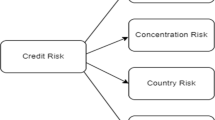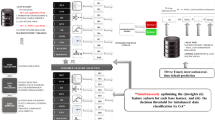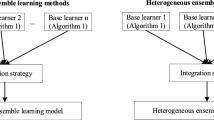Abstract
This paper proposes novel multi-objective optimization strategies to develop a weighted ensemble model. The comparison of the performance of the proposed strategies against simulated data suggests that the multi-objective strategy based on joint entropy is superior to other proposed strategies. For the application, generalization, and practical implications of the proposed approaches, we implemented the model on two real datasets related to the prediction of credit risk default and the adoption of the innovative business model by firms. The scope of this paper can be extended in ordering the solutions of the proposed multi-objective strategies and can be generalized for other similar predictive tasks.









Similar content being viewed by others
Notes
Business model innovation refers to changes in the existing structure of assets and operations (i.e., business model) that a company uses to deal with the market. Whether a firm at strategic level realizes this or not, business model is always there, which could be either in evident or latent form. In principle, the underlying logic or architecture of any business always refers to the business model in place. A firm changes many decisions at strategic level across various functions which may lead to the overall innovation of the existing business model. Specifically, it is the combination of several changes in different functions of business which matters the most in innovating the business model. The design of the survey is done in such a way to capture information of the changes done across different functions within the firm. Such integrated changes of different functions in the business most likely lead to innovation of the business model. In abstract sense, the binary dependent variable “business model innovation” is nothing but a function of individual indicators that refers changes in the business model. More precisely, business model innovation is a function BMI = f (f3, p7, f2, n5, ...), which is a linear combination of individual indicators of business model change. We thank an anonymous referee for helping to make this point clearer.
For credit risk dataset, the class size, their distribution after SMOTE are (9342, 10,899) and (46%, 54%) respectively. For business model dataset, the class size, their distribution after SMOTE are (1881, 2037) and (48%, 52%) respectively.
EMM1 refers the proposed strategy 3, EMM2 to strategy 4, EMM3 to strategy 2, and EMM4 to strategy 1. EMS1, EMS2, EMS3 and EMS4 refers to the single-objective optimization function of the proposed four strategies and follows the same sequence of EMM1, EMM2, EMM3, and EMM4.
EMM2 refers to the proposed multiobjective strategy 3 and EMS2 is a single-objective version of EMM2. EMM2 and EMM1 are interchangeably the same as they have been developed using strategy 3, it is just two different convention for evaluating the performance on two different datasets.So, is the case with EMS1 and EMS2. The other models in Table 4 stands for GLM(generalized linear model), RF(random forest), and BMA(Bayesian moving average).
References
Bäck, T. (1996). Evolutionary algorithms in theory and practice: Evolution strategies, evolutionary programming, genetic algorithms. Oxford University Press.
Banner, K. M., & Higgs, M. D. (2017). Considerations for assessing model averaging of regression coefficients. Ecological Applications, 27, 78–93.
Belton, V., & Stewart, T. (2002). Multiple criteria decision analysis: An integrated approach. Springer.
Breskvar, M., Kocev, D., & Džeroski, S. (2018). Ensembles for multi-target regression with random output selections. Machine Learning, 107, 1673–1709.
Burnham, K., & Anderson, D. R. (2002). Model selection and multi-model inference: A practical information-theoretic approach. Springer, 26(2), 1–488.
Chawla, Nitesh V., Bowyer, Kevin W., Hall, Lawrence O., & Philip Kegelmeyer, W. (2002). SMOTE: Synthetic Minority Over-sampling Technique. Journal of Artificial Intelligence Research, 16, 321–57.
Coello, C. A. C., Lamont, G. B., & Van Veldhuizen, D. A. (2007). Evolutionary algorithms for solving multiobjective problems. Springer.
Deb, K. (2001). Multiobjective optimization using evolutionary algorithms (pp. 1–518). Wiley.
Deb, K. (2001). Multiobjective optimization using evolutionary algorithms. Wiley.
Dellnitz, M., Schutze, O., & Hestermeyer, T. (2005). Covering pareto sets by multilevel subdivison techniques. Journal of Optimization Theory and Applications, 124(1), 113–136.
DeLong, E. R., DeLong, D. M., & Clarke-Pearson, D. L. (1988). Comparing the areas under two or more correlated receiver operating characteristic curves: a nonparametric approach. Biometrics, 837–845.
Ehrgott, M. (2005). Multicriteria optimization. Springer.
Ehrgott, M. (2012). Vilfredo Pareto and multiobjective optimization. Optimization stories. Journal der Deutschen Mathematiker-Vereininggung, Extra, 21, 447–453.
Fletcher, S., Verma, B., & Zhang, M. (2020). A non-specialized ensemble classifier using multi-objective optimization. Neurocomputing, 409, 93–102.
Ignizio, J. P. (1976). Goal programming and extensions. Lexington Books.
Izui, K., Yamada, T., Nishiwaki, S., & Tanaka, K. (2015). Multiobjective optimization using an aggregative gradient-based method. Structural and Multidisciplinary Optimization, 51, 173–182.
Jin, Y. (2006). Multi-objective machine learning (Vol. 14, pp. 1–660). Springer.
Jürgen, B., Kalyanmoy, D., Kaisa, M., & Roman, S. (2008). Multiobjective optimization: Interactive and evolutionary approaches. Springer.
Kordík, P., Černý, J., & Frýda, T. (2018). Discovering predictive ensembles for transfer learning and meta-learning. Machine Learning, 107, 177–207.
Kou, G., Peng, Y., & Wang, G. (2014). Evaluation of clustering algorithms for financial risk analysis using MCDM methods. Information Sciences, 275, 1–12.
Kou, G., Xu, Y., Peng, Y., Shen, F., Chen, Y., Chang, K., & Kou, S. (2021). Bankruptcy prediction for SMEs using transactional data and two-stage multiobjective feature selection. Decision Support Systems, 140, 113429.
Kou, G., Xiao, H., Cao, M., & Lee, L. H. (2021). Optimal computing budget allocation for the vector evaluated genetic algorithm in multi-objective simulation optimization. Automatica, 129, 109599.
Kozodoi, N., Lessmann, S., Papakonstantinou, K., Gatsoulis, Y., & Baesens, B. (2019). A multi-objective approach for profit-driven feature selection in credit scoring. Decision Support Systems, 120, 106–117.
Krawczyk, B. (2016). Learning from imbalanced data: Open challenges and future directions. Progress in Artificial Intelligence, 5(4), 221–232.
Kuncheva, L., & Whitaker, C. (2003). Measures of diversity in classifier ensembles and their relationship with the ensemble accuracy’’. Machine Learning, 51(2), 181–207.
Li, T., Kou, G., Peng, Y., & Yu, P. S. (2021). An integrated cluster detection, optimization, and interpretation approach for financial data. IEEE Transactions on Cybernetics, 1–14.
Mackay, D. J. C. (2003). Information theory, inferences, and learning algorithms. Cambridge University Press.
Murphy, K. (2012). Machine learning: A probabilistic perspective. MIT Press.
Peimankar, A., Weddell, S. J., Jalal, T., & Lapthorn, A. C. (2018). Multi-objective en- semble forecasting with an application to power transformers. Applied Soft Computing, 68, 233–248.
Ribeiro, V. H. A., & Meza, G. R. (2020). Ensemble learning by means of a multi-objective optimization design approach for dealing with imbalanced data sets. Expert Systems with Applications, 147, 113–232.
Rosales-Perez, A., Garcia, S., Gonzalez, J. A., Coello, C. A. C., & Herrera, F. (2017). An evolutionary multi-objective model and instance selection for support vector machines with Pareto–based ensembles. IEEE Transactions on Evolutionary Com- putation, 1.
Sahâ, S., Sarkar, D., & Kramer, S. (2019). Exploring multi-objective optimization for multi-label classifier ensembles. IEEE Congress on Evolutionary Computation (CEC), 2019, 2753–2760.
Shi, C., Kong, X., Fu, D., Yu, P. S., & Wu, B. (2014). Multi-label classification based on multi-objective optimization. Association for Computing Machinery, 5(2), 1–22.
Smith, C., & Jin, Y. (2014). Evolutionary multi-objective generation of recurrent neu- ral network ensembles for time series prediction. Neurocomputing, 143, 302–311.
Tan, C. J., Lim, C. P., & Cheah, Y. N. (2014). A multi-objective evolutionary algorithm- based ensemble optimizer for feature selection and classification with neural network models. Neurocomputing, 125, 217–228.
Tumer, K., & Ghosh, J. (1996). Analysis of decision boundaries in linearly combined neural classifiers. Pattern Recognition, 29(2), 341–348.
Wang, W., et al. (2019). An effective ensemble framework for multiobjective optimization. IEEE Transactions on Evolutionary Computation, 23(4), 645–659.
Wang, F., Li, Y., Liao, F., & Yan, H. (2020). An ensemble learning based prediction strategy for dynamic multi-objective optimization. Applied Soft Computing, 96, 106592.
Wozniak, M., Graña, M., & Corchado, E. (2014). A survey of multiple classifier systems as hybrid systems. Information Fusion, 16, 3–17.
Zhang, C., & Yunqian, M. (2012). Ensemble machine learning: Methods and applications. Springer.
Zhao, J., Jiao, L., Xia, S., Basto Fernandes, V., Yevseyeva, I., Zhou, Y., Emmerich, T. M., & M. (2018). Multiobjective sparse ensemble learning by means of evolutionary algorithms. Decision Support Systems,111, 86–100. https://doi.org/10.1016/j.dss.2018.05.003
Zhao, H. (2007). A multi-objective genetic programming approach to developing Pareto optimal decision trees. Decision Support Systems, 43(3), 809–826.
Author information
Authors and Affiliations
Corresponding author
Additional information
Publisher's Note
Springer Nature remains neutral with regard to jurisdictional claims in published maps and institutional affiliations.
Appendix
Appendix
1.1 Details on credit risk dataset
1.2 Details on business model innovation dataset
See Table 9
Rights and permissions
Springer Nature or its licensor (e.g. a society or other partner) holds exclusive rights to this article under a publishing agreement with the author(s) or other rightsholder(s); author self-archiving of the accepted manuscript version of this article is solely governed by the terms of such publishing agreement and applicable law.
About this article
Cite this article
Jha, P., Cucculelli, M. Enhancing the predictive performance of ensemble models through novel multi-objective strategies: evidence from credit risk and business model innovation survey data. Ann Oper Res 325, 1029–1047 (2023). https://doi.org/10.1007/s10479-022-05028-0
Accepted:
Published:
Issue Date:
DOI: https://doi.org/10.1007/s10479-022-05028-0




